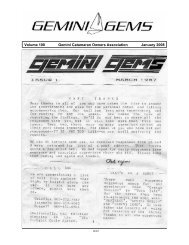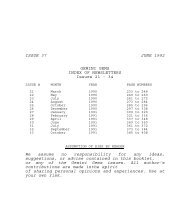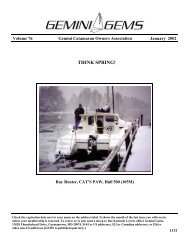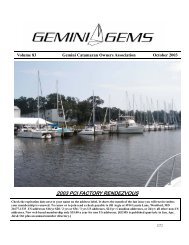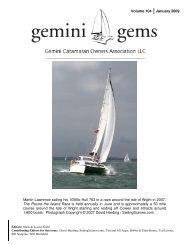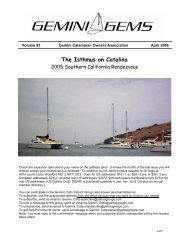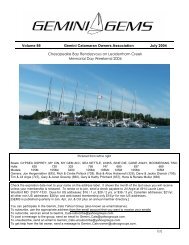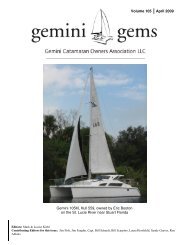Gemini Owners Manual.pub - Gemini Gems
Gemini Owners Manual.pub - Gemini Gems
Gemini Owners Manual.pub - Gemini Gems
You also want an ePaper? Increase the reach of your titles
YUMPU automatically turns print PDFs into web optimized ePapers that Google loves.
<strong>Gemini</strong> 105Mc Owner’s <strong>Manual</strong><br />
Operational Checklists<br />
The following operational checklists are for reference only<br />
and may not include all possible actions. We suggest using<br />
these lists as an example to which you can add your own<br />
items.<br />
Before Getting Underway<br />
Make sure your registration certificate is visible<br />
or documentation is onboard and available.<br />
Make sure you have charts of the area and compass<br />
on board. Check marine weather forecast.<br />
Coast Guard Safety Kit (see page 36) and all<br />
safety equipment onboard in working order.<br />
Make sure engine cooling water seacock is in<br />
the “open” position—check for cooling water in<br />
Turn battery switch to position 1 or 2 and turn<br />
instruments to the “On” position.<br />
Lower one centerboard for slow speed maneuvering.<br />
Lower drive leg for motoring—periodically check<br />
and re-grease drive leg lock claw.<br />
Confirm location and quantity of PFD’s for each<br />
person aboard and place throw-able PFD in cockpit.<br />
Check engine oil, transmission oil, coolant, and<br />
fuel levels and visually inspect engine hoses,<br />
belts, and engine bilge.<br />
Start engine, check for cooling water exhaust,<br />
and allow engine to come up to operating temperature.<br />
Turn off master shore power switch and disconnect<br />
shore power cable.<br />
Turn on VHF radio—turn to the emergency channel:<br />
16.<br />
Check to make sure bilges are dry.<br />
For an extended voyage, issue a float plan with<br />
a friend. Include when and where you are leaving<br />
from, when and where your destination is,<br />
and a description of your boat.<br />
If you have air conditioning, turn the cooling<br />
water seacock to the “upright” position so as not<br />
to lose the system’s prime.<br />
A second person onboard should be capable of<br />
operating the boat, including the drive leg, engine,<br />
and radio.<br />
Remove leeward dock lines and then windward<br />
dock lines before leaving the slip.<br />
Before Leaving the Boat<br />
Raise and tighten both centerboards in the full<br />
up position—lower the rudders.<br />
Raise drive leg and close off red valve by the<br />
pump.<br />
Turn the main battery switch to “off.”<br />
Replace sail cover and ensure all hatches, windows,<br />
and doors are shut and locked completely.<br />
If leaving for an extended time, turn refrigerator<br />
off and then turn propane off at the bottle.<br />
If leaving briefly (and you want to leave the<br />
refrigerator running on propane), make sure<br />
refrigerator is running through the Xintec Propane<br />
Detection system—and leave the batteries<br />
“On.”<br />
Double-check all dock lines.<br />
If you have air conditioning, be sure the cooling<br />
water seacock is the “open” position before<br />
Lock main cabin door.<br />
Minimal Toolkit to Have Onboard<br />
Set of screwdrivers—various sizes of flat head<br />
and philips head<br />
8” Adjustable Wrench<br />
8” Vice Grip Wrench<br />
Socket Set—Metric<br />
Wrenches—Metric<br />
Oil Filter Wrench<br />
Copyright © 2004 Performance Cruising Inc.<br />
47



